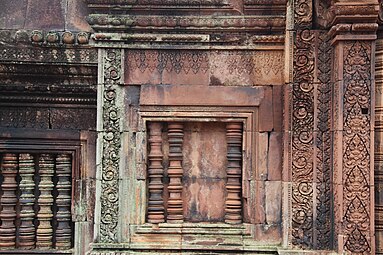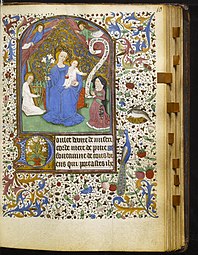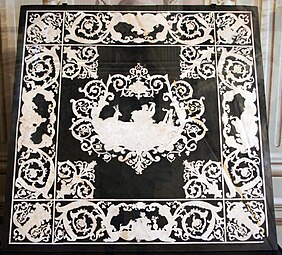Rinceau

In architecture and the decorative arts, a rinceau (plural rinceaux; from the French, derived from old French rain 'branch with foliage') is a decorative form consisting of a continuous wavy stemlike motif from which smaller leafy stems or groups of leaves branch out at more or less regular intervals. The English term scroll is more often used in English, especially when the pattern is regular, repeating along a narrow zone. In English "rinceau" tends to be used where the design spreads across a wider zone, in a similar style to an Islamic arabesque pattern.
The use of rinceaux is frequent in the
The rinceau experienced a return to the simpler Classic style in the 17th century, and in the subsequent century it was applied more freely, without a strict repetition of identical forms.[2]
Gallery
-
Ancient Greek rinceau on a mosaic of a stag hunt, Pella, Greece, unknown architect or craftsman, 4th century BC
-
Ancient Greek rinceaux on a krater, by the painter of Copenhagen 4223, 340-320 BC, ceramic, National Archaeological Museum, Madrid, Spain
-
Late Roman-early Byzantine rinceaux in the Mausoleum of Galla Placidia, Ravenna, Italy, unknown architect or craftsman, 425-450
-
Byzantine rinceaux on a ceiling of Basilica of San Vitale, Ravenna, unknown architect or craftsman, begun in c.532 and consecrated in 548[5]
-
Byzantine rinceaux on a ceiling of Basilica of San Vitale, unknown architect or craftsman, begun in c.532 and consecrated in 548[6]
-
Byzantine rinceaux with animals on the Throne of Archbishop Maximian of Ravenna, 546-556, ivory, Archiepiscopal Museum, Ravenna[7]
-
Khmer rinceaux on Banteay Srei, Siem Reap province, Cambodia, unknown architect or sculptor, 10th century
-
Byzantine rinceaux on a panel with peacocks, c.1100, marble, Church of Santa Maria Assunta, Torcello, Italy[8]
-
Romanesque rinceaux on a page from the Bury Bible, by Master Hugo, c.1135-1140, illumination on parchment, Corpus Christi College, University of Cambridge, the UK
-
Gothic rinceaux next to the door of the Rouen Cathedral, Rouen, France, unknown architect, 12th century
-
Gothic rinceaux ironwork on a door of the Notre-Dame de Paris, attributed to the locksmith Biscornet, 12th-13th centuries
-
Gothic rinceaux ironwork on anarmoire, 14th century, wood and iron, Museum of Decorative Arts, Paris
-
Chinese rinceau on a bowl, 1368-1450, porcelain, Los Angeles County Museum of Art, US
-
Gothic rinceau on a page with the adoration of the magi from an illuminated manuscript, 1415-1420, tempera colors, gold paint, gold leaf, and ink on parchment, Getty Center, Los Angeles
-
Gothic rinceau on a leaf from a book of hours, c.1460, parchment with ink, paint, and gold, Walters Art Museum, Baltimore, US
-
Renaissance rinceaux in the Cathedral Basilica of Saint Cecilia, Albi, France, unknown painter, c.1480
-
Islamic rinceaux of the Sheikh Lotfollah Mosque, Isfahan, Iran, designed by architect Ostad Mohammad Reza Isfahani, 1603-1619
-
boiserie of a room from the Hôtel Colbert de Villacerf, now in the Musée Carnavalet, Paris, unknown architect, sculptor and painter, c.1650[9]
-
Baroque rinceaux in theHôtel Salé (now the Musée Picasso), Paris, designed by Jean Boulier de Bourges, 1656-1659
-
Baroque rinceaux on a table top with Orpheus, by Annibale Grifoni, 1660-1679, unknown materials, Villa medicea di Cerreto Guidi, Cerreto Guidi, Italy
-
Baroque rinceaux on boiserie in the Galerie d'Apollon, Louvre Palace, by Louis Le Vau and Charles Le Brun, after 1661[11]
-
Potlogi, Romania, unknown architect or sculptor, 1698
-
Baroque rinceaux on anMuseum of Decorative Arts, Paris
-
Baroque rinceaux on a commode, by André-Charles Boulle, c.1710–1720, walnut veneered with ebony, marquetry of engraved brass and tortoiseshell, and gilt-bronze mounts, Metropolitan Museum of Art, New York
-
Versailles, France, unknown architect, early or mid-18th century
-
Mughal and European-influenced rinceaux of the Peacock Gate of the City Palace, Jaipur, India, unknown architect or painter, 1729-1732[12]
-
Neoclassical rinceaux railing in the Belsay Hall, Belsay, Northumberland, the UK, by Sir Charles Monck, 1810-1817
-
Neoclassical rinceaux on a vase, by the Sèvres Porcelain Manufactory, 1814, hard-paste porcelain with platinum background and gilt bronze mounts, Louvre[13]
-
Gothic Revival rinceau on the choir carpet of Notre-Dame de Paris, by the Gobelins Manufactory, 1825-1833, textile, Notre-Dame de Paris[14]
-
Neoclassical rinceaux on a stock certificate, unknown illustrator, 1852, ink on paper, unknown location
-
, 1858-1860
-
Baroque Revival rinceaux with putti on a ceiling in the apartments of the minister of state, currently known as the Napoleon III Apartments, Louvre Palace, unknown architect or sculptor, c.1860
-
Neoclassical rinceaux with a mascaron of Rue des Vinaigriers no. 57, Paris, designed by E. Escudie, 1882
-
Neoclassical rinceaux on a grille at an entrance of the Salle Favart, Paris, probably designed by Louis Bernier, 1893-1898
-
Romanian Revival rinceau on the Gheorghieff Brothers Tomb, Bellu Cemetery, Bucharest, Romania, by Ion Mincu, c.1900
-
Beaux Arts over door with rinceaux in Strada Zborului no. 2, Bucharest, unknown architect or designer, c.1900
-
Gothic Revival cartouche with rinceaux of Strada Temișana no. 4, Bucharest, unknown architect, c.1900
-
Art Nouveau rinceaux on the of Lavirotte Building (Avenue Rapp no. 29), Paris, designed by Jules Lavirotte and decorated with sculpture and ceramic tiles made by Alexandre Bigot, 1901
-
Beaux Arts fresco with cartouches and foliage spirals on the upper part of the facade of Strada Occidentului no. 11, Bucharest, painter: C. Cora, architect: Cesare Fantoli, 1910[16]
-
Neo-Louis XVI style panel with rinceaux and an urn in the Nicolae T. Filitti/Nae Filitis House (Calea Dorobanților no. 18), Bucharest, by Ernest Doneaud, c.1910[17]
-
Romanian Revival rinceau in the Gheorghe Petrașcu House (Piața Romană no. 5), Bucharest, by Spiru Cegăneanu, 1912[18]
Notes
- ^ Cf. J. Ward, Historic Ornament: Treatise on Decorative Art and Architectural Ornament, BiblioBazaar (2009), s.v. Rinceau.
- ^ Cf. A. Speltz, The History of Ornament: Design in the Decorative Arts, Portland (1989), s.v.
- ^ "Temple of Apollo at Didyma". brown.edu. Retrieved 6 March 2024.
- ISBN 978-0-500-02236-8.
- ISBN 978 0 7148 4810 5.
- ISBN 978 0 7148 4810 5.
- ISBN 978 0 7148 4810 5.
- ISBN 978 0 7148 4810 5.
- ^ "LAMBRIS DU CABINET DE L'HÔTEL COLBERT DE VILLACERF". carnavalet.paris.fr. Retrieved 31 August 2023.
- ISBN 978-1-84484-899-7.
- ISBN 978-0-500-02544-4.
- ISBN 978 0 7148 7727 3.
- ^ "PAIRE DE VASES « FUSEAU »". amisdulouvre.fr. Retrieved 10 May 2023.
- ^ "tapis de choeur Louis-Philippe". pop.culture.gouv.fr. Retrieved 5 October 2023.
- ISBN 978-0-500-29148-1.
- ^ Oprea, Petre (1986). Itinerar Inedit prin Case Vechi din București (in Romanian). Editura Sport-Turism. p. 59.
- ISBN 978-606-94042-8-7.
- ISBN 978-973-0-23884-6.
See also
- Margent
- Scroll
- Scrollwork
- Volute
- Acanthus (ornament)
External links
- Decorating with Art, Antiques and Collectibles
- Home Economics Archive: Tradition, Research, History (HEARTH)
An e-book collection of over 1,000 books on home economics spanning 1850 to 1950, created by Cornell University's Mann Library. Includes several hundred e-books on decorative art and design, particularly that created within the home. - Victoria and Albert Museum
- The Bard Graduate Center (BGC) for Studies in the Decorative Arts, Design and Culture
- Parsons/Cooper-Hewitt Program in the History of Decorative Arts & Design
- Digital Library for the Decorative Arts and Material Culture - electronic resources
- Metropolitan Museum of Art American decorative arts collection
- National Gallery of Art decorative arts collection



![Ancient Greek rinceaux on a capital from the ruins of the Temple of Apollo at Didyma, Turkey, unknown architect or sculptor, c.300-150 BC[3]](http://upload.wikimedia.org/wikipedia/commons/thumb/f/f5/Didyma_2013-03-25zd.jpg/383px-Didyma_2013-03-25zd.jpg)
![Roman rinceau in an arabesque on the Ara Pacis, Rome, unknown architect and sculptors, 13-9 BC[4]](http://upload.wikimedia.org/wikipedia/commons/thumb/9/97/Panel_of_Tellus%2C_Ara_Pacis%2C_Rome_%28II%29.jpg/170px-Panel_of_Tellus%2C_Ara_Pacis%2C_Rome_%28II%29.jpg)


![Byzantine rinceaux on a ceiling of Basilica of San Vitale, Ravenna, unknown architect or craftsman, begun in c.532 and consecrated in 548[5]](http://upload.wikimedia.org/wikipedia/commons/thumb/a/a5/Basilica_of_San_Vitale_-_Lamb_of_God_mosaic.jpg/319px-Basilica_of_San_Vitale_-_Lamb_of_God_mosaic.jpg)
![Byzantine rinceaux on a ceiling of Basilica of San Vitale, unknown architect or craftsman, begun in c.532 and consecrated in 548[6]](http://upload.wikimedia.org/wikipedia/commons/thumb/9/94/Ravenna_San_Vitale_204.jpg/383px-Ravenna_San_Vitale_204.jpg)
![Byzantine rinceaux with animals on the Throne of Archbishop Maximian of Ravenna, 546-556, ivory, Archiepiscopal Museum, Ravenna[7]](http://upload.wikimedia.org/wikipedia/commons/thumb/d/dd/Ravenna_Museo_Arcivescovile_174.jpg/360px-Ravenna_Museo_Arcivescovile_174.jpg)

![Byzantine rinceaux on a panel with peacocks, c.1100, marble, Church of Santa Maria Assunta, Torcello, Italy[8]](http://upload.wikimedia.org/wikipedia/commons/thumb/a/af/Scuola_veneto-bizantina%2C_plutei_marmorei_del_1050-1100_ca.jpg/258px-Scuola_veneto-bizantina%2C_plutei_marmorei_del_1050-1100_ca.jpg)









![Baroque rinceaux with putti painted on the boiserie of a room from the Hôtel Colbert de Villacerf, now in the Musée Carnavalet, Paris, unknown architect, sculptor and painter, c.1650[9]](http://upload.wikimedia.org/wikipedia/commons/thumb/f/f0/H%C3%B4tel_Colbert_de_Villacerf_3.jpg/191px-H%C3%B4tel_Colbert_de_Villacerf_3.jpg)
![Baroque rinceaux on the chest for Louis XIV's gems, mid-17th century, repoussé and chiselled gold over a wooden core, Louvre[10]](http://upload.wikimedia.org/wikipedia/commons/thumb/8/85/My_kind_of_jewelry_box_%2830079398526%29.jpg/332px-My_kind_of_jewelry_box_%2830079398526%29.jpg)


![Baroque rinceaux on boiserie in the Galerie d'Apollon, Louvre Palace, by Louis Le Vau and Charles Le Brun, after 1661[11]](http://upload.wikimedia.org/wikipedia/commons/thumb/0/0f/Detail_of_the_Galerie_d%27Apollon_%2836%29.jpg/155px-Detail_of_the_Galerie_d%27Apollon_%2836%29.jpg)




![Mughal and European-influenced rinceaux of the Peacock Gate of the City Palace, Jaipur, India, unknown architect or painter, 1729-1732[12]](http://upload.wikimedia.org/wikipedia/commons/thumb/8/82/India_2015-187_%2817164938015%29.jpg/340px-India_2015-187_%2817164938015%29.jpg)

![Neoclassical rinceaux on a vase, by the Sèvres Porcelain Manufactory, 1814, hard-paste porcelain with platinum background and gilt bronze mounts, Louvre[13]](http://upload.wikimedia.org/wikipedia/commons/thumb/f/f4/Pair_of_Spindle_Vases_-_OA_11090_-_Louvre_%2808%29.jpg/306px-Pair_of_Spindle_Vases_-_OA_11090_-_Louvre_%2808%29.jpg)
![Gothic Revival rinceau on the choir carpet of Notre-Dame de Paris, by the Gobelins Manufactory, 1825-1833, textile, Notre-Dame de Paris[14]](http://upload.wikimedia.org/wikipedia/commons/thumb/9/93/Notre-Dame_de_Paris_-_Tapis_monumental_du_ch%C5%93ur_-_028.jpg/383px-Notre-Dame_de_Paris_-_Tapis_monumental_du_ch%C5%93ur_-_028.jpg)






![Beaux Arts rinceau on the Petit Palais, Paris, by Charles Giraud, 1900[15]](http://upload.wikimedia.org/wikipedia/commons/thumb/4/42/PetitPalaisParisIngresso.jpg/191px-PetitPalaisParisIngresso.jpg)



![Beaux Arts fresco with cartouches and foliage spirals on the upper part of the facade of Strada Occidentului no. 11, Bucharest, painter: C. Cora, architect: Cesare Fantoli, 1910[16]](http://upload.wikimedia.org/wikipedia/commons/thumb/c/c4/11_Strada_Occidentului%2C_Bucharest_%2805%29.jpg/314px-11_Strada_Occidentului%2C_Bucharest_%2805%29.jpg)
![Neo-Louis XVI style panel with rinceaux and an urn in the Nicolae T. Filitti/Nae Filitis House (Calea Dorobanților no. 18), Bucharest, by Ernest Doneaud, c.1910[17]](http://upload.wikimedia.org/wikipedia/commons/thumb/f/f5/18_Calea_Doroban%C8%9Bilor%2C_Bucharest_%2802%29.jpg/659px-18_Calea_Doroban%C8%9Bilor%2C_Bucharest_%2802%29.jpg)
![Romanian Revival rinceau in the Gheorghe Petrașcu House (Piața Romană no. 5), Bucharest, by Spiru Cegăneanu, 1912[18]](http://upload.wikimedia.org/wikipedia/commons/thumb/1/1b/5_Pia%C8%9Ba_Roman%C4%83%2C_Bucharest_%2834%29.jpg/190px-5_Pia%C8%9Ba_Roman%C4%83%2C_Bucharest_%2834%29.jpg)
